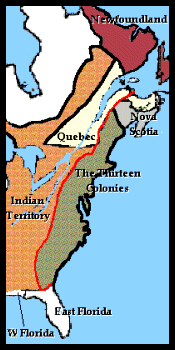
The Proclamation of 1763
Start and Extention dates
October 7, 1763 king George III issued the Proclamation (Greenspan), in 1768 the treaty was expanded giving the colonies more land (Brinkley,100).
Purpose
From the British viewpoint the French and Indian war, was a sign that they needed to rein in the settlers. They thought that the settlers were getting too rambunctious and bold in their expansion to the west, as a result causing a war with the French. Due to the settler’s inability to produce enough soldiers to end the war, the British had to step in to finish a war they didn't start. England felt that the American colonies were overstepping their boundaries, in regard to their carelessness in dealing with foreign powers being the Indians. England had to limit settler’s expansion westward to prevent them from engaging in greater conflicts that would take a grater toll on the British recourses (US History) The proclamation was also intended to help pay back the Indians for their loss of land, and establish boundaries that the rapidly expanding American colonies could not cross, to maintain Indian land sovereignty (Britannica).

Effected the most in the colonies
Many farmers were negatively affected by this proclamation because they wanted to expand their land. The royal proclamation put British officials along the border of what was designated Indian territory. This enraged farmers who wanted more land to grow more crops. The British also sought to improve their own fur trade (US history). They strictly limited the American merchant's trading ability with the Indians, so they could increase their own trade(Britannica).
Provisions
The proclamation established new British territories in the Americas: the province of Quebec, East Florida, West Florida, and Grenada. They created a huge Indian reservation west of the Appalachian mountain range that was to be strictly Indian lands. Settlers were to have any interaction with tribes unless authorized by British authorities. The proclamation of 1763 was the first establishment of the idea of land titles for Indian, in which there was a fine and between American and Indian territories (Britannica).


Response
For the most part the colonies ignored these laws and continued to push westward into Indian territories, American leaders such as Washington, and Patrick Henry believed that the proclamation would soon be repealed due to England inability to hold back the Americans (Greenspan). Lord Dunmore a governor of Virginia also showed a lot of optimism about expansion into the west, and became close friends with Washington who offered to give him a tour of the Ohio valley (Anderson, 254). The border control enacted by the British was very costly and Britain taxed the colonies to pay for it. This only created more discontentment with the English (US History). In 1768, new agreements were made with the western tribes and the boundary was extended, but still this failed to strop American further expansion westward (Brinkley, 100).
Tensions between colonies and England
Many of the American's believed that the English were trying to take advantage of them. They were trying to limit the American’s expansion and continue to completely rule over them by limiting their westward expansion. By completely cutting ties between the Indians and the Americans, the colonists believed the British were trying manipulating the colonies for their own benefit (Greenspan). This only raised the tensions between the English and Americans, and spurred them on to seeks independence from England.
Works Cited
Anderson, Fred. The War That Made America. New York: Penguin, 2006. Print.
Brinkley, Alan. The Unfinished Nation. New York: McGraw-Hill, 2010. Print.
Greenspan, Jesse. "Remembering the Proclamation of 1763." History. A&E Television Networks, 7 Oct. 2013. Web. 19 Oct. 2015. <http://www.history.com/news/remembering-the-proclamation-of-1763>.
"Proclamation of 1763." Encyclopedia Britannica. N.p., 4 Apr. 2015. Web. 19 Oct. 2015. <http://www.britannica.com/event/Proclamation-of-1763>.
"The Proclamation of 1763." US History. Independence Hall Association, n.d. Web. 19 Oct. 2015. <http://www.ushistory.org/declaration/related/proc63.htm>.
Pictures
Map-http://www.ushistory.org/declaration/related/proc63.htm
Document-http://www.history.com/topics/native-american-history/1763-proclamation-of
black and white fight scene-http://www.veteranstoday.com/2014/08/30/law-criminality-and-assaults-on-indigenous-peoples/
